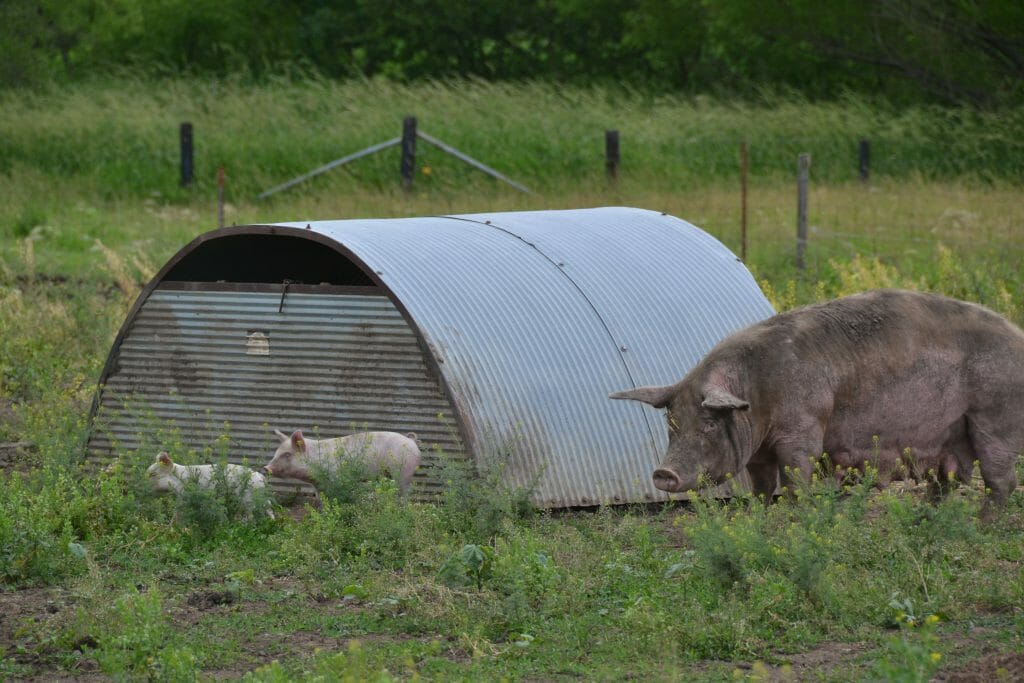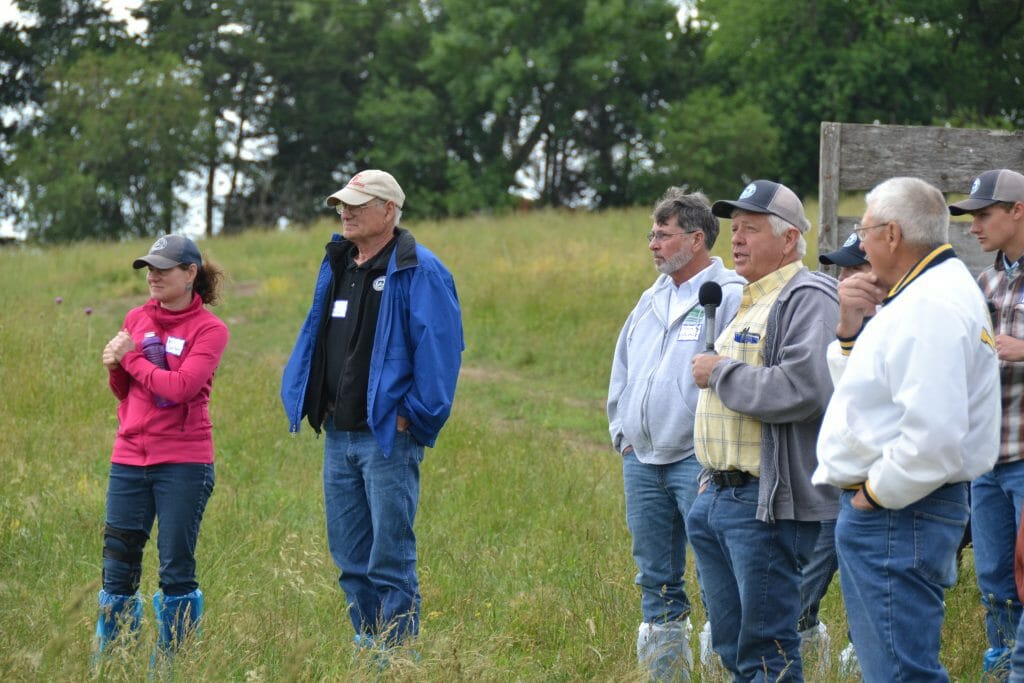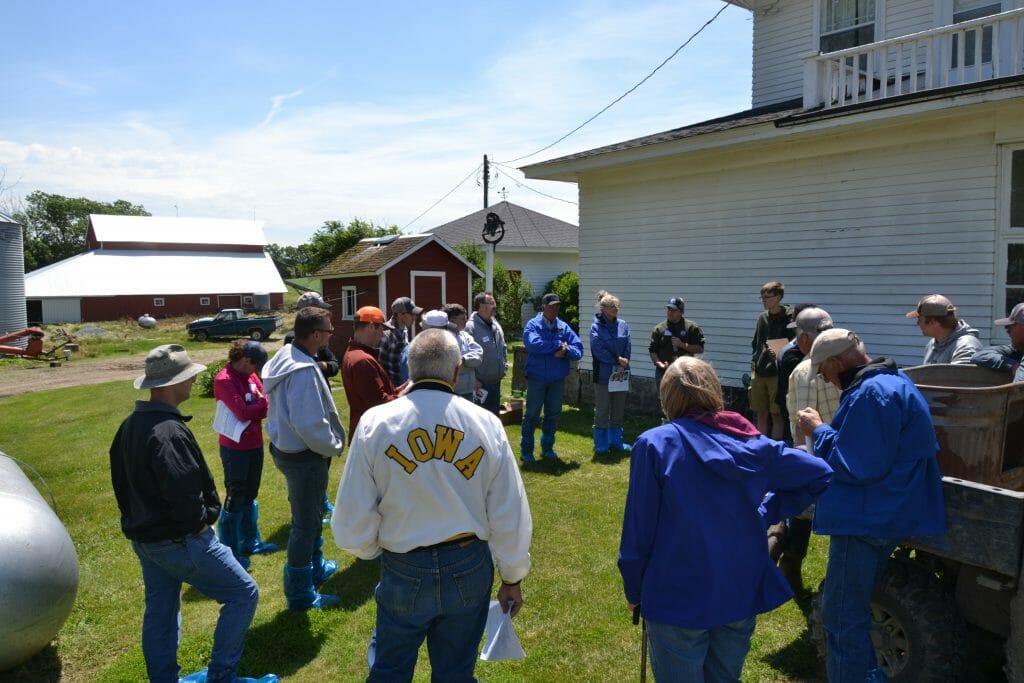Pig Health in Alternative Production Systems
How do pig producers avoid health crises and reduce the chronic effects of disease, all while maximizing profitability? Unfortunately, there is not a single quick-fix strategy. Herd health strategies bring multiple practices into a package to successfully raise healthy pigs. Farms with healthy pigs grow faster and gain more efficiently. In a pasture-based system, the priority should be disease prevention and eradication, rather than disease treatment. Drew White, a veterinarian for Niman Ranch, shared a checklist for raising healthy pigs in a pasture-based system at Ron Mardesen’s field day. “Every farm is different and every farm will have their own disease prevalence,” Drew says, “Work with your veterinarian to develop a case sensitive protocol and health procedures for your farm.”

Ron Mardesen strives to achieve pastured farrowing by July 1 due to the heat. His typical pasture mix is comprised of different cool season grasses.
Healthy Pigs Begin With a Healthy Sow
Vaccinating sows prior to farrowing maximizes disease resistance and protects newborn pigs from pathogens and parasites. Newborn pigs acquire temporary passive immunity to diseases through the sow’s colostrum. Build immunity for piglets through the sow by following proper vaccination protocols and sample a sow’s manure to reduce parasite shedding. Drew’s general vaccination recommendations for all producers are:
- A combination of leptospirosis/parvovirus/erysipelas vaccine should be given at 2- and 5-weeks pre-breeding for incoming gilts, also administered to all sows at weaning, and to boars twice a year.
- A combination of clostridium perfringens type C and E.coli given at 2- and 5-weeks pre-farrow for gilts and 2 weeks pre-farrow for sows – helping to reduce the risk of piglet scours in the farrowing pen or hut.
- Between ten days and three weeks of age, piglets should receive a single dose of ileitis vaccine. At 3- and 6-weeks of age, administer a combination Circo Myco vaccination, and at 6 weeks give an Erysipelas vaccine.
Three diseases that cause the most economic loss to pig producers are: mycoplasma, circovirus and PPRS. “In Iowa if you are north of I-80 – a PPRS-dense area – you should be vaccinating for PRRS. South of I-80 or in an area with a lesser population of pigs you don’t need to vaccinate for PRRS, but be mindful and prepare with measures of biosecurity,” says Drew.

Ron Mardesen hosted a field day near Elliot, Iowa on June 14. This field day showcased different phases of pig production and veterinarian Drew White discussed health management practices alongside Ron.
African Swine Fever
African Swine Fever (ASF) is a serious, highly contagious viral disease in pigs. Outbreaks of the disease have recently been occurring across the globe. While ASF is not currently in the U.S., several experts believe it will arrive in the future either through feed shipments or infected uncooked pork products. If and when ASF makes it on to U.S. soil, all pig producers conventional and non-conventional need to prepare. Currently, there is no vaccine available for ASF.
Drew recommends all pig producers adopt a biosecurity plan and obtain a premise ID to report to IDALS. “If ASF comes to the U.S., the USDA will close off regions and their bordering states. Farms inside the quarantined zone will need a permit allowing pigs to leave the farm,” he notifies, “If you do not have a biosecurity plan, pigs will not leave your farm. A plan and premise ID are needed to obtain a permit to sell pigs off the farm if ASF is present on U.S. soil.“ To obtain a premise ID contact the Iowa Premise Identification Program through the Iowa Department of Agriculture and Land Stewardship.
Dewormers
“It is important to start deworming early. Sows should be wormed 3-4 weeks after breeding and 1-2 weeks before farrowing. This will help to reduce the number of worms and eggs a sow will shed around the piglets,” Drew advises, “Piglets should be dewormed 2-3 weeks after weaning or upon arrival at a wean-to-finish farm, and then every 6-8 weeks until pigs are market ready. “
Pigs can be dewormed in their water, feed or by injection. “Take fecal samples on sows and piglets regularly to know if you need to deworm or not.” Drew recommends administering dewormer through an injectable for sows and gilts and through the feed for finishing pigs.
Feed Particle Size
Grain comprises the primary energy source of swine diets. Producers should be concerned with not only the nutritional quality of the grain, but also how it is processed. Pig producers should check ground grain or one complete diet at least twice per year and for larger farms, every 3 months. Drew recommends to keep the grind of your feed between 650-850 microns for the most effective pig growth. Compared to when it gets too fine (around 400 micros) which might cause ulcers, reduced feed intake and increased risk of respiratory problems.
“Over 850 microns, pigs will be less likely to digest feed properly. For example, if pigs are not digesting feed properly they will not receive the full benefit of their feed. Which leads the pigs to present vices like tail and jowl biting,” says Drew.

Drew White, a veterinarian with Niman Ranch discusses vaccinations, dewormers, and disease management for an alternative swine farm.
Mycotoxins
Pigs are extremely sensitive to mycotoxins. Mycotoxins even at low levels reduce performance in growing and breeding pigs. “Mycotoxins are mold that can grow not only in the feed but in bedding. If you see mold on your straw hay or corn stalks – the sows and piglets will be exposed to get – you need to be feeding a mycotoxin binder at all times,” says Drew.
The effect of mycotoxins varies depending on the amount ingested, the time over which it is consumed and the age of the exposed pig. Some mycotoxins can be passed through the milk from sows to their litters. Young pigs, breeding sows and boars are generally the most susceptible to mycotoxins.
When to Call the Vet
Prevention and early disease detection are essential for pigs in a pasture-based system. In an antibiotic-free system, you need to vaccinate before a disease prevents itself. Careful observation of your pigs is essential for early detection of symptoms. Take a cough for example. What percentage of pigs are coughing? Is it dry or productive? Do they cough only when they first get up or continually? These types of observations will help your vet determine what interventions can be used. If you see these signs call your vet:
- 1% death loss in a week or 3% death loss in a month
- Cough or scours noted with 15% or more of the group
- If any of these signs are seen: abortions; vomiting; abnormal skin lesions; bloody scours; neurologic issues
In a pasture-based system, pigs are integrated and exposed to the whole farm environment, presenting unique challenges in herd health basics. It isn’t impossible to manage for these principles and strategies in alternative swine systems. Communicate with your veterinarian, develop a plan, follow your protocol, and keep proper records. To see the handout Drew provided for attendees at the field day, click here.
